The secrets of vanilla – why do we love its perfume? This spice is as sweet as it is heady, with multiple virtues; a star of perfumery with an influence across the world, and a delight to perfumers! Sweet and animalic, its gourmand notes contrast with its leathery facets, which soften, warm and coat the most unique fragrances! We’ll tell you all about this iconic perfumery ingredient.
The only orchid with a sweet vanilla scent!

Vanilla Planifolia, flowers
In the undergrowth of humid tropical regions, a mysterious creeper grows in the shade. Known as the vanilla tree, this very delicate orchid hides edible fruits called pods. Green and plump, 7 to 25 cm long, they give birth to a spice: vanilla
Perfume and vanilla, the story of a star ingredient
Vanilla landed in the 17th century!
It was the Totonacs, occupying the coastal regions of the Gulf of Mexico, who produced vanilla and supplied it to the Aztec Empire. It is even said that they used it to flavour their cocoa drinks!
Vanilla was discovered in the 16th century by the Spaniards during their conquest of the American continent. After it arrived at the Spanish court, it crossed the borders and became a real craze in Europe. Increasingly appreciated at the French court, a royal edict established its sales monopoly in 1662. It was not until the beginning of the 19th century that vanilla arrived in Bourbon on Reunion Island. However, it was impossible to obtain the famous beans there…
How is vanilla fragrance obtained in perfumery?
Let’s go back to Mexico, its country of origin. Here, vanilla is fertilised by a small bee: the melipona. While foraging on flowers, it brings together the male and female organs of the flower to give birth to the pod.
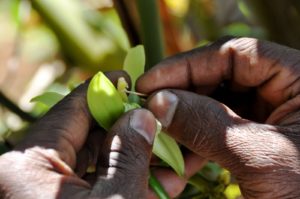
Manual pollination of vanilla
But this famous melipona bee does not live on Reunion Island. It wasn’t until 1841 that Edmond Albius, a slave botanist, discovered how to manually fertilise vanilla flowers with a bamboo tip. Unbelievable but true: today, a worker can fertilise 1000 to 1500 flowers per day!
An almost human maturation cycle?
As with humans, it is 9 months after fertilisation that the pods announce themselves to be ripe to leave their mother vanilla tree! In the first stage of scalding, they are immersed in water at 65°C for 3 minutes to stop their maturation process, and also to trigger the development of aromas. Then, under steam for 12 hours, the vanilla takes on its lovely chocolate colour and develops its sumptuous fragrance. During the following 15 days, the pods dry in the sun and continue to develop their aromas and fragrances, as well as their multiple virtues!
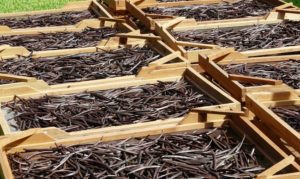
Drying of vanilla beans on racks
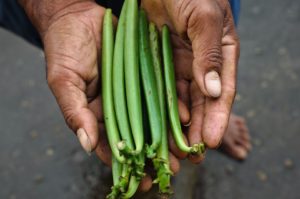
Immature green pods
Today, and for many years now, Madagascar has been home to 60 to 80% of the world’s production.
The extraction of vanilla beans in perfumery!
The volatile solvent extraction of vanilla dissolves the beans in a solvent which is then allowed to evaporate. The beans are then immersed in a vat called an extractor, then washed with ethanol – a solvent that extracts the vanilla smell – before being brought to boiling point.
Result: the evaporation of the solvent gives rise to a very fragrant paste called resinoid. After further washing with ethanol and several glazes, the purified concrete gives birth to vanilla absolute. And that’s the one everyone is clamouring for!
Vanilla perfume, a beloved scent
The vanilla industry, the favourite perfume of the French!
The vanilla bean is surprising, not only for its disarming olfactory richness but also for its botanical nature. It is important to know that the food industry represents 80 to 85% of the demand for vanilla, and especially for the smallest ones! Naturally soft and slightly sweet, it is the queen amongst gourmands. Indeed, individuals, chocolate and ice cream makers, cooks, and pastry chefs are all very enthusiastic about it, as are the cosmetics and perfume industries!
This spice with its renowned taste is also known for its stimulating effects. It helps to fight fatigue, both intellectual and physical, and also has properties that stimulate the appetite, facilitate digestion, and help fight hysteria and depression. This vanilla is incredible!
Vanilla, a perfume combining happiness and pleasure?
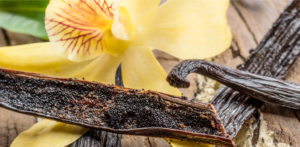
Vanilla bean with its seeds
Very enveloping, the vanilla bean is available in a complex palette of milky, almond, honeyed, smoky, aniseed, powdery, cocoa, smoky, woody, tabbouleh, rummy, balsam, and animal notes.
Bewitching and generous, it invites sweetness.
Hypnotic and sensual, it incites to sin.
Its addiction bewitches and that’s why it is so coveted in perfumery!
Vanilla, the star of perfumery
Vanilla perfume – too expensive to be true?
At 170€ per litre, few perfumes contain natural vanilla extracts. It is often substituted by much sweeter synthetic vanilla molecular accords, which replace or sublimate it.
Three forms of vanilla are used in perfumery:
– Vanilla absolute is obtained after extraction of the pods with a volatile solvent. Its leathery, warm, balsamic, almost smoky smell is less gourmand than the one we have in mind. In fact, the bean has a completely animal trail!
– Vanillin and the powerful ethyl-vanillin are synthetic molecules that are much less expensive. All sweet and powdery, these are gourmet vanilla beans, almost milky, with all the roundness we like.
– Vanilla tincture is made by macerating split beans in alcohol for about 1 month. This is a very rare technique that the House of Guerlain still uses sparingly, with an olfactory profile that is close to the absolute.
Which vanilla in perfumery?
Vanilla is the queen of oriental perfumes, brought up to date by Guerlain and Thierry Mugler, who have created the must-have vanilla perfumes.
In 1889, Jicky de Guerlain launched the first truly exceptional perfumes made with synthetic ingredients. Timeless in perfumery, it’s above all Shalimar de Guerlain that ranks first. It is a timeless reflection of the vanilla oriental, combined with ethyl-vanillin and bergamot, for a striking contrast!
Further, Thierry Mugler’s A*men bewitches with an overdosed vanilla-patchouli accord for its masculine fragrance.
Finally, Vanille Passion, by Comptoir Sud Pacifique, plays on the different facets of vanilla by combining black and green beans! Never before seen, with a hint of musks.
Other must-have interpretations are also built around vanilla. We find Guerlain’s Shalimar, Dior’s Addict, Chanel’s Allure, or Guerlain’s Habit Rouge in vanilla masculine scents.
Vanilla in perfumery accords
Essential for creating certain widely used accords, vanilla is a perfect partner for our greatest pleasure! It can be found in caramel, amber, or even floral accords – as with the lily, a mute flower from which it is impossible to naturally extract the scent.
Coupled with ethyl malthol, vanilla takes on a round caramel tone, a toffee caramel accord found in Thierry Mugler’s famous Angel. For the amber accord, vanilla is simply combined with labdanum, a leathery resin. As for the lily, some perfumers use vanilla and ylang-ylang to recreate its scent!
Vanilla perfume and its substitutes!

Tears of benzoin with vanilla scents
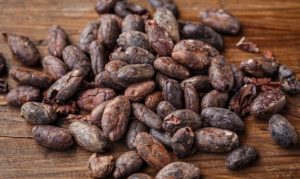
Cocoa beans with warm notes
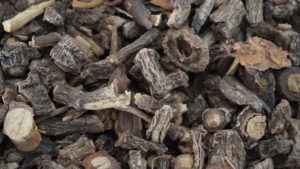
Vanillinia Decalepsis roots
Vanilla, while being the queen, occasionally cedes its throne to substitutes with similar riches! Benzoin can be used as a substitute. Sweet, honeyed and balmy, the resinous tears that flow from this tree have a magnificent vanilla trail. Cocoa also has lovely vanilla notes, as well as decalepsis. Its roots with their vanilla, powdery and almond scents are gradually making a reappearance in perfumery, even if they are still relatively unknown, and have a price tag of up to 800€/kg.
In a more powdery almond-like style, the tonka bean also reveals pretty vanilla notes, as does synthetic amber and its cleaner, more musky vanilla-balsam trail!
Vanilla, the diva of warm notes!
With its gourmand, sensual and tasty aspects, vanilla reveals a very warm side that can be found in many spicy perfumes to the great delight of women…and also men!
Tempting, it can be combined with gourmet fragrances such as pastries, sweets and liquorice for an enchantment that incites you to sin! Discover our Sillage #9 with caramel facets!
Coupled with woody notes, it has a velvet touch that wraps the fragrances in an infinite, comforting tenderness, like our woody and soft Sillage #286!
Irresistible in harmony with floral notes, it gives a fresh, round fragrance that can be worn in all seasons! Our Sillage #329 is the finest example of this!
Combined with smooth notes such as sandalwood or smoky notes, it expresses the richness of a more oriental world, which you can smell in our Sillage #451!
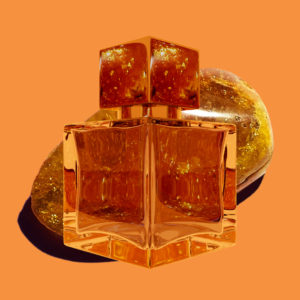
Like all of our ingredients, if you’ve never really had a taste of pure vanilla before and you’re spending a day in Paris, we invite you to come and visit us at Les Ateliers Parfum Sillages Paris! You will be able to smell all the most beautiful ingredients in our perfume organ!
If we have convinced you, why not take the plunge and add vanilla to your Sillage for unlimited hold? Tell us about it 😉
Let’s keep in touch! Follow us on Instagram.
And psssst, come and experience everything here in our sumptuous showroom!
Social